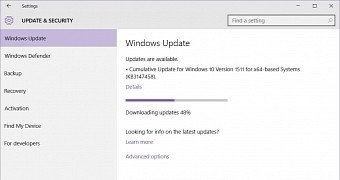Microsoft has just released Windows 10 cumulative updates KB3147458 and KB3147461, bringing improvements and fixes on computers running both the 10240 (RTM) version released in July and the 1511 (November Update) also known as TH2.
What’s important to note from the very beginning is that these updates aren’t part of the Windows Insider program, but are aimed at retail users who are running the stable build of Windows 10, be it TH1 or TH2. They are only available for PCs, but separate mobile updates are also expected soon.
What’s new in KB3147458
First and foremost, KB3147458 is the cumulative update aimed at 10586 computers, and it pushes version to .218.
It brings improved reliability for Internet Explorer 11 Edge browser, Cortana, Windows Explore, Bluetooth, map apps and a lot more, so it clearly improves the overall experience on the desktop.
It also fixes a big number of bugs, including problems that affected the lock screen or connectivity of USB devices. Microsoft details some of the fixes included in this update (you can see the full change log after the jump):
“Fixed additional issues with shutdown delays, Narrator, Cortana, roaming data usage, buying apps in the Store, video playback, facial recognition, Bluetooth pairing, Microsoft Edge, logon, Internet Explorer 11, Live Tile updates, .NET Framework, and Microsoft Installer (MSI).”
What’s new in KB3147461
KB3147461 is the update aimed at computers still running the July 2015 version and includes improved notifications in Start menu when updates need to be installed, better support for apps with barcode scanners, fixed issues with Internet Explorer and Microsoft Edge, and enhanced reliability for a number of apps, including Windows Explorer, Bluetooth MSI, Cortana, and OS restart.
There are some security fixes too, including for Microsoft Edge, HTTP.sys, Microsoft graphics component, secondary logon, Internet Explorer 11, Microsoft XML Core Service, Security Account Manager Remote protocol, .NET Framework, and Windows Hyper-V.
These updates are delivered through Windows Update and are installed automatically, although it remains to be seen how this goes given the problems experienced with previous releases.

 14 DAY TRIAL //
14 DAY TRIAL //